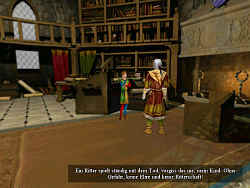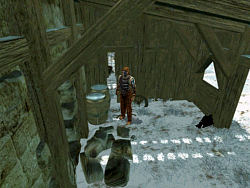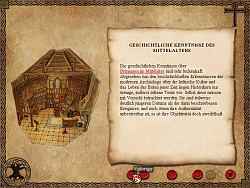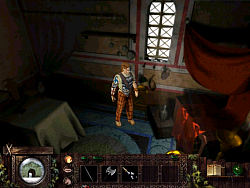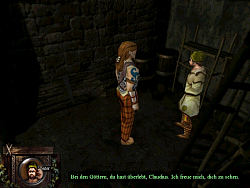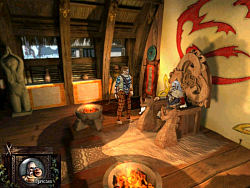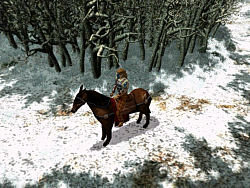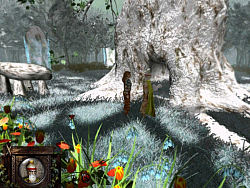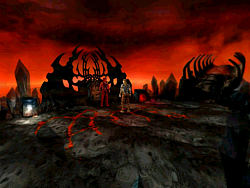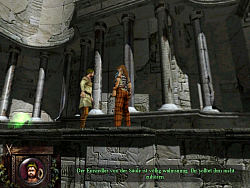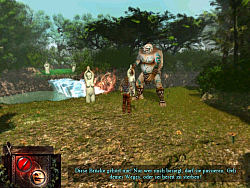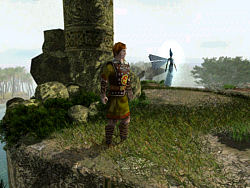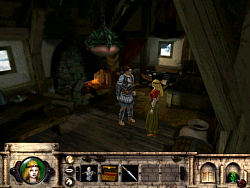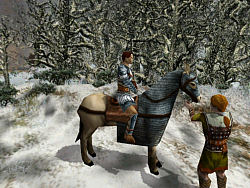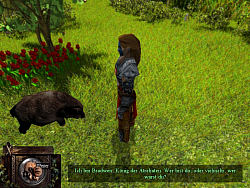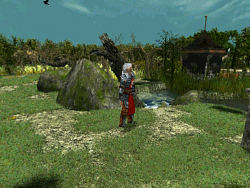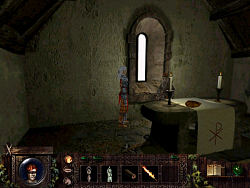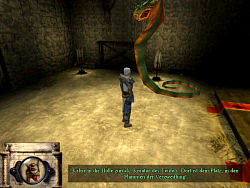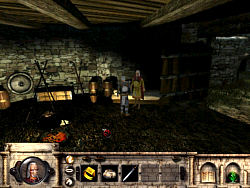Back
to Adventure-Archiv starting page
![]() Deutsche
Version dieser Seite
Deutsche
Version dieser Seite
Arthur's Knights - Volume 1 and 2
(Double Pack)
Developer/Publisher: Cryo
Homepage
Boxshots
Walkthrough part 1 german
Walkthrough
part 2 german
Walkthrough
part 1 english
Walkthrough
part 2 english
Download demo part
1 (32 MB), Trailer part 1 (16 MB), Trailer part 2 (6 MB)
A review by slydos 10th May 2002
| In November 2000 the German version of the
first part of King Arthur's-Saga was released under the name "King Arthur's Knights -
The Origins of Excalibur". A review from Adventure-Archiv for this game con be found here. Instead of releasing the already announced 2nd part of
the game, "Merlin's Secret", as single game, the deserving decision was made, to
publish both games at once here in Germany in a double pack box version at the price of
one game. A single release of the 2nd part: "Merlin's Secret", as in other
countries, is not available here. 4 games around one hero in 2 characteristics Exactly taken this are not only 2 games, but 4 independently playable adventures with our hero Bradwen, the illegitimate son of the Atrebate's king. In each of the two parts you can select whether you want to play with Bradwen as Christian-Roman hero or as Celtic-Druid warrior. One has the possibility at any time during the game of loading the savegames of the other character, to change between Bradwen the Celt or Bradwen the Christian. One can follow up his fate synchronously or successively, depending upon taste and concentration ability. Story In indeed epic breadth we are told not only Bradwen's story and of his people, the Celtic Atrebates. His story is closely interwoven with the events in Britain in the 6th century, are they actually truth or legend. The rule of the already Christian Romans was terminated by a renewed invasion, namely the invasion of the Saxons. They plundered and devastated the country which was split into many small and mutually war-leading kingdoms. While many people maintained the Roman-Christian religion, beside it there was a renaissance of the old Celtic customs and the faith in fairies, nature goddesses, ogres and dragons. This is Bradwen's starting point in the first volume. He is banished from the Atrebate's kingdom by his intriguing half brother and heir to the throne, Morganor. Depending on which story plot one selects, Merlin and the fairies or Bradwen's uncle Novelius, the bishop of Magovenium, monks and saints help to expose Bradwen's brother, find his wife and son and support king Arthur in the fight for unity and against the Saxons. Bradwen will become knight at Arthur's Round Table and can at last intersperse his claim on the throne of the Atrebates after many heavy blows and difficult tasks. This is the beginning of the second volume. Bradwen is only recognized as the true king if he could find the crown and wear it without injuries. But a powerful curse shows up in this moment, which afflicts Bradwen's whole family. In the Celtic part it is the curse of the mother goddess Morgan, in the Christian of the holy Epona. Bradwen's whole efforts are now focused on the abolition of the curse and re-establishment of the family honour. By magic Bradwen is shifted 20 years forward in time and finds many of his friends dead, the throne occupied by an usurper and also king Arthur's star goes down. How does Bradwen handle this situation? Installation/starting the game In the euro box package we find 3 CDs and a multilingual, illustrated manual for each game part. The installation under Windows ME for both parts runs automatically and smoothly and you arrive in the "character selction" menu. This is to that extent confusing, as one could think here, it would be already here possible to select the Celtic or the Christian way. But this menu only provides the possibility to choose from separate savegames for each player. After that the main menu appears. Here you can adjust various screen and sound options clicking on the "options"-menu. Afterwards one can start a new game and reach the framing story: In the 14th century we see the young French page Nai on his way to storyteller and writer Master Foulque. Master Foulque has just finished the first part of Bradwen's story and asks the young boy to choose, which of the two stories he would like to hear first - the Christian or the Celtic. This framing story already shows up in 3D and 3rd-person-perspective, whereby we take over the role of the young page. Already here we must advance in the discussion with master Foulque by mouse-click and have to control the the boy's movements with the arrow keys. Nai represents here the critical player, who asks the master questions about the sense and purpose of the story. After each completed chapter the two emerge again and talk about what they've seen and experienced. Nai can select now between the red book - "Celt" - or the white book - "Christian" -. Master Foulque then begins to tell the appropriate story... We can now watch the starting sequence which is the same in all 4 games, telling the story of Britain from the pact between humans and fairies up to the invasion of the Saxons. Afterwards we get a short introduction by text and speech about the current starting situation and may then finally intervene into the happenings. Controls/handling We see our hero in 3rd-person-perspective and control him with the 4 arrow keys of our keyboard to let him run or ride his horse. If we press the shift-key at the same time, then he rides or runs faster. If we want to take or manipulate an object or speak to a person, we have to press spacebar. This are all keys, which we must note, everything else is controlled with the two mouse buttons. At the screen we receive nearly no hints, if there is any hotspot around to interact with. One must try a lot and actually must position Bradwen's front correctly to the object, if possible, and then press spacebar. If he cannot use anything there, he just shrugs. If we succeeded in taking up an object in this manner, this action is also indicated at the upper left of the screen showing the corresponding icon. Particularly at the beginning its very probable that you ignore objects or don't open doors, because you simply did not stand correctly in front of them. In conversations one must also position Bradwen correctly, but here you get some help, because as soon as our hero arrives near an individual, with which he can talk, at the bottom left corner the picture of this person is faded in. If you click on it, the conversation can begin - if you are standing correctly and close enough! By the way, one cannot act or talk during running or riding. Dialogues are continued, by clicking again on the icon of the interlocutor, until you get repeated answers. But in many cases that is not the end of the conversation. Often we get new references, which are put down in the clue inventory during a dialogue. We must now open the clue inventory - represented by a mouth -, and can click on a new topic there. If everything is said, the topic icon is darkened. We can scroll through the clue inventory, the object inventory and the travel inventory to the left and right. One should miss that in no case, since only 5 icons are shown in each case at one time and you'll often forget something. The 3 inventories are integrated into a control bar at the bottom of the screen, which can be opened by right click with the mouse. One opens the object inventory with a click on the hand icon, the destination inventory with click on the horse head. The destination inventory takes up new, far distant locations, usually during conversations. By a click on such an icon you are directly transported there. I must admit that I erred around Uffington at the beginning of my first Arthur-game for a while and did not get ahead, without knowing that already a new destination was in my inventory, where the game could continue. However destinations can be only used, when Bradwen is on horse back. This is described in the manual - thus one should read it before!! In the control bar are still two more important icons on the right side. A diary, in which all important stations and tasks are noted down automatically. This is really helpful if one has lost orientation. The book shows also, at which point of the story you are at the moment. It's divided into tasks (5 in part 1and 4 for in part 2), this tasks are again devided into chapters. The manual says that one can repeat scenes from the diary by clicking the appropriate hand icons! This doesn't work! I did not succeed in this anyhow! The last icon, a green glass ball, leads back to the main menu. We can save or load one of the maximal 10 stored savegames. Beside a small scene icon, date and time and chapter numbers are stored here. Different Handling There is only one but very important difference in the handling between part 1 and 2: In the second part of the saga one can click on the location picture on the left of the control bar, and so in each case get a map of the area. In the first volume this great feature hasn't been integrated. Here one often errs around through the forest of Arden and has to draw a map. In the second part not only the map but also Bradwen's own location are indicated in each case! A substantial improvement! Graphics With "Arthur's Knights" Cryo for the first time uses the 3rd-person-perspective in an adventure. ("Odyssey" and "Time Machine" were developed by In Utero and published by Cryo). We move 3D-characters (occasionally we also control Corwyn, Bradwen's squire) in a 3D-environment, which is populated by many other 3D-creatures. I did not play "Odyssey", but had to fight with the extraordinary annoying controls of the main character in "Time Machine". Constant changes of perspective and running into objects and finally even complete disappearing from the scope were clear weak points here. Not so with "Arthur's Knights"! We also find changes of view here - however they are appropriate and confuse under no circumstances. I would call the changes of view in "Arthur's Knights" already rather movie like, they are interesting and make the game more genuine. Our hero does not run in walls or tables and he's not running out of view. No miracle - if you read the credits there are 29 !!! people, who worked particularly on the 3D-graphics. Nevertheless there are still better graphics around. The characters and animals are angular and roughsharp-edged, there is no mimic and only little gesturing adapting to the situation. (my favourite for 3D-characters is still Dragon Riders, with mimic and gesturing synchrone to the speech.) As it's the case for many other 3D-games the characters seem cold and have little charisma. If the company praises the graphics in this game, they should at least equip the main characters with moving lips when talking. The number of locations is large and varied. No doubt that you can visit approx. 80% of the locations in the second volume again, but here the winter landscape is replaced by spring meadows and trees covered with leaves. It is interesting to watch, how the forest roads or the area of Tintagel changes in spring. While e.g. Camelot is no more visited in the second part, there are new scenes and also some new faces to see, we don't know yet from part one. Also Bradwen and the other main characters change their appearance and age. We see Bradwen in different shapes, as Celtic warrior he has body paintings and tattoos. Completely in contrast Bradwen, the Christian, with short hair and the clothes of a Roman warrior. Also his horse is saddled in a different way. Those background graphics are very detailed - despite some rough textures - contrary to many pure 3D-adventures and are homeland for a multiplicity of animals and indifferent persons, which move independently in their own rhythm. There are butterflies, sheep, bears, wolves, fish, deer, pigs and much more to animate the scenes. Beside those, the movements of our main characters are also near to life. Both humans and animals are genuine in their proportions. Bradwen's horse is trotting and galloping and changes the direction like a genuine horse (case someone searches a horse with wrong proportions: in "Wild Wild West" you can find one). If we let Bradwen run faster and then stop him, he must regain his balance, but not as clumsy, as our young page Nai. You can watch Bradwen breathing and if he bends down or opens a door it all looks genuine. The few film sequences are nevertheless quite faded and indistinct - so the starting sequence or for example the dragon scene in the 2nd part of "Arthur's Knights". On the other hand there are some beautiful 2D-pictures. In each case with the change to another main location, clear and detailed 2D-landscapes are faded in during the transition. Speech/text/sound The speakers are throughout professional. They return at least partially the expression and character to our actors, that they are missing through the sharp-edged and expressionless 3D-presentation. Except few medieval music themes (during visiting the menus) the game remains music-free. The atmosphere of the individual scenes is shaped however by a large number of most diverse noises. There are mostly animal sounds, like those of cats lolling everywhere or the bleating of lambs. However I found it somewhat exxagerated to hear bleating sheep, where far and broad no sheep could be seen, or the gurgling drinking sound of the alcoholic monk can be heard in the whole monastery. But usually the noises are also at the correct places - on the right or on the left, depending on how our hero moves. However in both games the noise, which horses cause was missing to me, if they gallop over grass or a road. If Bradwen was horse riding, it was more a silent movie and not only in the winter landscapes of the first part. But there is spooky resounding child laughter in the forest of Arden - or was it the laughter of fairies? In nearly all cases the spoken text is also shown at the screen. Also documents are usually read out. In both volumes Bradwen is accompanied most of the time by his faithful squire, who even becomes the main character sometimes. Usually one sees him only, when he helps Bradwen on the horse, but one often hears his anxious, surprised or referring shouts from the off, when our hero enters a new area. Once there was an involuntary amusing spoken text, when Bradwen calls for the fairy Fiachra: "Fiachra - I call for your powers!" sounded exactly the same as "Viagra - I call for your powers!" Puzzles The puzzles are throughout of the easy to middle kind. Usually you must get objects, clues or new destinations during the really many conversations to solve the lot of tasks. Many puzzles are nested. Places and persons must be visited again and again, because there is always something new to experience and find. Often there are homogeneous puzzles one after the other, e.g. giving a fairy the correct answers from a selection several times or searching objects of the same kind. Partly that can become quite boring. But especially boring became the distances between the individual locations for me, when I knew exactly, what has to be done, but had to ride several times to and fro. At the beginning riding is in the snow-covered forest/or in the spring forest still fun, but when you have to do it repeatedly and also must note down the right ways on your own drawn map (at least in the 1st volume of "Arthur's Knights") and can't shorten the distance it gets annoying. Even with the shift-key it lasted a very long time, until one could do something productive again. There are some puzzles where you must find a correct sequence. There are always hints to the solutions. If forgotten or not noticed, we can always get ahead however by trying. Objects cannot be combined by the gamer. If one has got e.g. three fitting parts, they are built together automatically. The game is linear and there are, except for a very tiny exception, no dead ends. You can die however rather often, usually if you begin a fight too hasty. You do not have to fight by yourself. Thus no fear - there are no actual gamer-controlled action sequences. But Bradwen is a knight and must defeat from time to time an opponent to get ahead. Then you can select within the dialogue picture at the bottom left corner whether you want to fight or not. If you decide to fight, you can back-lean and watch Bradwen and his opponents doing what they have to do. If Bradwen loses, we are sent back automatically into the framing story with Master Foulque, where page Nai asks, how the story can be continued now. We have the immediate possibility, to take up the game through the menu option "continue game", sometimes however from a prior point in the game, so that here and there saving the game is recommendable. (By the way, I had most of the numerous game crashes exactly at such points, when Bradwen had died and I wanted to load or take up the game again.) The puzzles in the Celtic and Christian versions are just as different as the stories. We often must find the same objects, but always in a completely different way. The puzzle degree of difficulty increases with increasing playing time. Towards the end you'll have more objects, clues and destinations than at the beginning. Always helpful is the diary, if you couldn't remember a task for example. A walkthrough is not necessary, really - who wants to shorten however some boring passages in the forest of Arden or Avalon thereby... Technical problems I registered both in the first and second volume frequent game crashes. Particularly annoying: always CD1 of three CDs has to be inserted first to start again. Additional thoughts In both parts of "Arthur's Knights" there is a quite detailed data base about Britain, Arthur, the legends of the Celts etc.. Who wants more background information can at least get some suggestions here. The story of the Christian Bradwen ends in the 2nd part - "Arthur's Knights - Merlin's Secret" - somewhat abruptly and with a contentwise error. My impression is, that there wasn't enough time here to bring this part of the game to a proper end, because nevertheless some questions remained open. The sub-title "Merlin's Secret" of the second volume is mismatching - in the Christian part Merlin does not play a large role and in the Celtic part another secret is the main subject. The before planned sub-title "The Hidden King" would have better met the thing. Although the two parts are independently playable, one should nevertheless observe the order. The 2nd part refers to many events of the 1st part, e.g. when Corwyn refuses accompanying Bradwen to Avalon in the 2nd part you should at least know why. In addition Bradwen, the Celt in the 2nd part, has some objects from the 1st part in his inventory when starting. Who thus does not know the 1st part, will know little about this items. Those of you who must begin however with "Merlin's Secret" first, can read a summary of the 1st volume in the diary. Summary The stories, which are told here, are unusually extensive and detailed, have many side plots and a detailed prehistory. I was more than 5 weeks busy with all 4 games. However the very long playing time of all games results partially from the time-consuming riding routes. Adventure fans, who prefer however more tricky and challenging puzzle food, will not be satisfied with the 4 King Arthur adventures. Impressive the various ideas in graphic design and the presentation of the scenes at different seasons. It was really interesting to be able to experience the stories from two completely different points of view. Unfortunately there were so much game crashes where you repeatedly had to insert CD1. That should not occur with a modern game any longer. Nevertheless, because of the very interesting story and to the good price/product relationship the complete edition of "Arthur's Knights" receives a 68% rating from me. Adventure-Archiv-rating system:
|
|
Minimal system requirements:
- Windows 95/98
- 64 MB
- Pentium II 300 Mhz Prozessor (recommended P II 350 Mhz)
- 120 MB free space on hard disk
- 8 MB 3D video card
- 8x CDROM-drive (recommended 16x CDROM-drive)
- System must be DirectX7 compatible
Played on:
- WindowsME
- Pentium III 850
- 128 MB RAM
- Sound- and graphic card DirectX-compatible
- Toshiba DVD-ROM
Copyright © slydos for Adventure-Archiv, 10th May 2002
Back to Adventure-Archiv starting page

